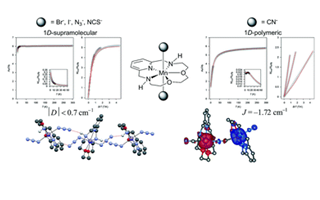Publication in RSC Advances
 Publication entitled “Structural and magnetic properties of heptacoordinated MnII complexes containing a 15-membered pyridine-based macrocycle and halido/pseudohalido axial coligands” (authors: B. Drahoš, R. Herchel, Z. Trávníček) has been published in the chemistry journal RSC Advances. The aim of the work was to reveal the impact of axial ligands on the structure and magnetic anisotropy of pentagonal-bipyramidal mononuclear Mn(II) complexes with general formula [Mn(15-pyN3O2)X2], where 15-pyN3O2 is 15-membered pentadentate pyridine-based macrocycle and X is monodentate halogenido/pseudohalogenido ligand (Br–, I–, N3–, NCS–), and polymeric complex {[MnL(-CN)](ClO4)}n. Due to the large group of characterization physico-chemical methods it was found that the substitution of axial ligands has a very small effect on the magnetic anisotropy (|D| ≤ 0,7 cm–1), but it strongly influences the formation of hydrogen-bond network which connects mononuclear complex units in the crystal structure into supramolecular 1D-chains. Based on DFT calculations, these hydrogen-bonds mediate very weak antiferromagnetic exchange interaction between the manganese centers. A weak antiferromagnetic exchange interaction was found in {[MnL(-CN)](ClO4)}n as well, but in this case it was mediated by bridging cyanido ligand.
Publication entitled “Structural and magnetic properties of heptacoordinated MnII complexes containing a 15-membered pyridine-based macrocycle and halido/pseudohalido axial coligands” (authors: B. Drahoš, R. Herchel, Z. Trávníček) has been published in the chemistry journal RSC Advances. The aim of the work was to reveal the impact of axial ligands on the structure and magnetic anisotropy of pentagonal-bipyramidal mononuclear Mn(II) complexes with general formula [Mn(15-pyN3O2)X2], where 15-pyN3O2 is 15-membered pentadentate pyridine-based macrocycle and X is monodentate halogenido/pseudohalogenido ligand (Br–, I–, N3–, NCS–), and polymeric complex {[MnL(-CN)](ClO4)}n. Due to the large group of characterization physico-chemical methods it was found that the substitution of axial ligands has a very small effect on the magnetic anisotropy (|D| ≤ 0,7 cm–1), but it strongly influences the formation of hydrogen-bond network which connects mononuclear complex units in the crystal structure into supramolecular 1D-chains. Based on DFT calculations, these hydrogen-bonds mediate very weak antiferromagnetic exchange interaction between the manganese centers. A weak antiferromagnetic exchange interaction was found in {[MnL(-CN)](ClO4)}n as well, but in this case it was mediated by bridging cyanido ligand.


